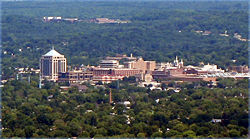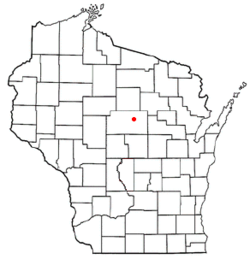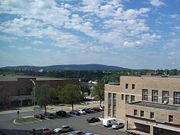Wausau, Wisconsin
| Wausau, Wisconsin | |
 |
|
 |
|
| Coordinates: | |
| County | Marathon |
|---|---|
| Government | |
| - Mayor | Jim Tipple |
| Area | |
| - City | 46.0 km² (17.8 sq mi) |
| - Land | 42.7 km² (16.5 sq mi) |
| - Water | 3.3 km² (1.3 sq mi) 7.15% |
| Elevation | 368 m (1,207 ft) |
| Population (2004) | |
| - City | 38,426 |
| - Density | 899.7/km² (2,330.7/sq mi) |
| - Metro | 127,733 |
| Time zone | Central (UTC-6) |
| - Summer (DST) | Central (UTC-5) |
| Website: http://www.ci.wausau.wi.us/ | |
Wausau (pronounced /wô'sô/) is a city in and the county seat of Marathon County, Wisconsin, United States. The city is located at an altitude of 364.2 meters (1,195 ft). The Wisconsin River divides the city. Wausau is 180 miles (290 km) east of Minneapolis, Minnesota. The city is located adjacent to and partially surrounded by the town of Wausau. According to the 2000 census, Wausau had a population of 38,426 people.
Wausau is the core city of the Wausau Metropolitan Statistical Area (MSA), which includes all of Marathon County and had a population of 125,834 at the 2000 census. Besides Wausau, other significant communities in the metropolitan area include Schofield, Rothschild, Weston, Kronenwetter, and the town of Rib Mountain. It is the 297th largest MSA in the United States.
Contents |
History




Founding
The Wisconsin River is what first drew settlers to the area during the mid-1800s. Known as Big Bull Flats or Big Bull Falls by the original French explorers. The long rapids created many bubbles (bulle, in French). A treaty was formed with the Chippewa Indians in 1836 that transferred land to federal ownership. The current name of the city is Wausau, pronounced Waasaa, meaning "a faraway place" or "a place which can be seen from far away" in the Ojibwe language.
George Stevens, who lent his name to Stevens Point about half an hour's drive south of Wausau, in 1840 began processing the pine forests into lumber. Subsequently, other sawmills along the Wisconsin River began to spring up as well.
By 1846, Walter McIndoe arrived and took the lead in the local business and community. His efforts helped, in part, to establish Marathon County in 1850.
Early settlers
By 1852, Wausau had been established as a town and continued to grow and mature. German immigration into the area brought more people, and by 1861, the town was incorporated as a village.
Churches, schools, industry and social organizations began to flourish with the State of Wisconsin granting the now city a charter in 1872, with elections to be held the first Tuesday in April. The residents elected August Kickbusch as their first mayor.
When the railroad arrived in 1874, Wausau was even more accessible to people and industry, still mostly focused on lumber production. This technology allowed the city to continue to grow and flourish, even as other villages and towns in the area were forced to close due to the rapidly vanishing forests and closing of the lumber mills.
20th century
Wausau's favorable location on the Wisconsin River was partly responsible for the city's survival. Furthermore, the economy was being reformed and diversified in the early 1900s by an insurance group who would later be known as the Wausau Group or Wausau Insurance Companies. Its logo, first introduced in 1954, was the downtown Milwaukee Road railroad depot, which was set against the backdrop of the community's skyline. This company put Wausau in the minds of people across the country.
As with the arrival of the railroad, the arrival of the automobile helped improve roads in the area.
The stock market crash in 1929 had a major effect on the Wausau area. Many industries were forced to cut back by laying off and dismissing workers or by closing all together. After decades of positive growth, the city had virtually ground to a halt. However, under the New Deal, Wausau was heavily modernized. And after World War II, the city once again continued to grow, in industry, education, recreation, and retail more so than population.
In 1983, the Wausau Center shopping mall opened and still exists today.
By the middle and late 1990s, the city of Wausau began to purchase and develop more of the West Industrial Park to meet the needs of the expanding economy and companies.
In the late 1990s, the city tore down a number of aging buildings on a square in the center of downtown and created what is known locally at the 400 Block, an open, grassy block with paved sidewalks criss-crossing it. The square is a focal point for summer festivals and lends a certain charm to the city's quaint downtown district.
The new millennium
By the end of the 20th century, the Wausau City Council had begun to implement the Redevelopment Plan, or the Wausau Central Business District Master Plan. This included redevelopment and economic structuring of downtown Wausau. Significant school construction in recent years has occurred in response to changing demographics.
Geography and climate

Geography
Wausau is located at .[1]
According to the United States Census Bureau, the city has a total area of 17.8 square miles (46.0 km²), of which, 16.5 square miles (42.7 km²) of it is land and 1.3 square miles (3.3 km²) of it (7.15%) is water. Interesting to note is that Wausau is very close to being at the very center of the northern half of the western hemisphere. Just west of Wausau, 45 degrees latitude meets 90 degrees longitude, which is exactly halfway between the Equator and the North Pole and a quarter of the way around the world from the Prime Meridian.
Climate
Wausau's climate is classified as being halfway between temperate and subarctic (boreal and hemiboreal). Wausau is built on or around a hemiboreal forest which has some of the characteristics of a boreal forest. Furthermore, they also share some of the features of the temperate-zone forests to the south. Coniferous trees predominate in the hemiboreal zone, but a significant number of deciduous species will be found there as well.
The area has four distinct seasons.
- Average annual precipitation: 31.6 inches (80.3 centimeters).
- Average daily high temperatures:
- January: 20.8 Fahrenheit (-6 Celsius)
- July: 84.3 Fahrenheit (29 Celsius)
Government and Politics
Wausau has a mayor-council form of government. Twelve elected alderpersons compose the city council, each representing one district of the city.
Economy
- Further information: List of companies in Wausau
Nearly one third of the Marathon County economy is manufacturing-based and the balance of service and industry provides a stable and productive workforce. Furthermore, the Wausau region has a consistently lower than average unemployment rate and continues a steady growth in job creation and economic viability among manufacturers and service providers alike. Wausau has twelve banks with 41 different branch locations, three trust companies and three holding companies located in metropolitan area. Furthermore, there are thirteen open membership credit unions with eighteen branch locations. Prominent industries of Wausau include paper manufacturing, insurance, home manufacturing, and tourism.
The Wausau area is also a center for cultivation of American ginseng.
Wausau is also known for its red granite, which is mined nearby.
Wausau is also home to America's largest producer of decorative concrete supplies, County Materials.
Wausau used to be the headquarters of Wausau Insurance, which is now Liberty Mutual. They have a regional office in Wausau. For several years, Wausau had TV ads stressing the confusion between Warsaw and Wausau.
Demographics
| Historical populations | |||
|---|---|---|---|
| Census | Pop. | %± | |
| 1870 | 1,349 |
|
|
| 1880 | 4,277 | 217% | |
| 1890 | 9,253 | 116.3% | |
| 1900 | 12,354 | 33.5% | |
| 1910 | 16,560 | 34% | |
| 1920 | 18,951 | 14.4% | |
| 1930 | 23,758 | 25.4% | |
| 1940 | 27,268 | 14.8% | |
| 1950 | 30,386 | 11.4% | |
| 1960 | 31,943 | 5.1% | |
| 1970 | 32,806 | 2.7% | |
| 1980 | 32,426 | −1.2% | |
| 1990 | 37,060 | 14.3% | |
| 2000 | 38,426 | 3.7% | |

Wausau is the larger principal city of the Wausau-Merrill CSA, a Combined Statistical Area that includes the Wausau metropolitan area (Marathon County) and the Merrill micropolitan area (Lincoln County),[2][3][4] which had a combined population of 155,475 at the 2000 census.[5]
As of the census[5] of 2000, there were 38,426 people, 15,678 households, and 9,328 families residing in the city. The population density was 2,330.7 people per square mile (899.7/km²). There were 16,668 housing units at an average density of 1,011.0/sq mi (390.3/km²). The racial makeup of the city was 85.91% White, 0.54% Black or African American, 0.59% Native American, 11.41% Asian, 0.04% Pacific Islander, 0.30% from other races, and 1.21% from two or more races. 1.04% of the population were Hispanic or Latino of any race were 1.04% of the population.
There were 15,678 households out of which 27.8% had children under the age of 18 living with them, 46.7% were married couples living together, 9.5% had a female householder with no husband present, and 40.5% were non-families. 33.6% of all households were made up of individuals and 14.1% had someone living alone who was 65 years of age or older. The average household size was 2.37 and the average family size was 3.08.
In the city the population was spread out with 25.4% under the age of 18, 9.6% from 18 to 24, 27.5% from 25 to 44, 20.4% from 45 to 64, and 17.1% who were 65 years of age or older. The median age was 36 years. For every 100 females there were 92.5 males. For every 100 females age 18 and over, there were 88.3 males.
The median income for a household in the city was $36,831, and the median income for a family was $47,065. Males had a median income of $33,076 versus $24,303 for females. The per capita income for the city was $20,227. About 7.2% of families and 11.4% of the population were below the poverty line, including 18.1% of those under age 18 and 8.4% of those age 65 or over.
Education
Colleges and universities
Wausau is home to the Northcentral Technical College, and the University of Wisconsin-Marathon County, a 2-year college which feeds the University of Wisconsin system. A major 4-year college is located in Stevens Point, about 30 miles (48 km) south of Wausau.
Public schools and libraries
Public schools located in the city are part of the Wausau School District. The main dividing line used to place students is the Wisconsin River which runs north to south through the city. The Wausau School District has fourteen elementary schools, two middle schools, and two high schools. The Wausau East High School sports teams are the Lumberjacks and the Wausau West High School [1] sports teams are the Warriors.
Charter school
Wausau Area Montessori Charter School comprises grades 1-6 and is housed at Horace Mann Middle School. Enrollment for the 2007-2008 school year finds WAMCS increasing from 50 students in 2006-2007 to 80 students this year. Two kindergarten classes are available at the Montessori Children's Village & Rib Mountain Montessori. Additionally, there is a The Montessori Parent/Teacher communication page.
Public Library
The Marathon County Public Library (MCPL) - Wausau Headquarters (online at www.mcpl.us) is the largest library in the Wausau area and is located downtown, near the Wausau Center Mall, at 300 North First Street. The MCPL - Wausau Headquarters was formed when the County and City libraries merged in 1974, and it serves as the headquarters for the Marathon County Public Library system, which encompasses all public libraries in Marathon County, including eight branch libraries located in Athens, Edgar, Hatley, Marathon, Mosinee, Rothschild, Spencer, and Stratford.
The MCPL - Wausau Headquarters is open seven days a week (six days a week between Memorial and Labor Day) and serves a population of 126,031. Free Internet access is available, including wireless access (Wi-Fi). Many of the Library's extensive electronic resources, including its online library catalog (V-Cat), are available online at www.mcpl.us.
Private schools
The city's Roman Catholic parochial schools are known as the Newman Catholic Schools. These include Newman Elementary Schools at St. Anne, St. Michael and St. Mark, Newman Middle School at St. Matthew's, and Newman Catholic High School. Newman High's sport teams are the Cardinals. Trinity Lutheran is a Missouri-synod-Lutheran grade school.
Transportation
Airports
- Central Wisconsin Airport
- Wausau Downtown Airport
Mass transit system
- Metro Ride
Sports
The Wisconsin Woodchucks are a baseball team that plays in the Northwoods League, an NCAA summer baseball league. Their home games are played at the Athletic Park in Wausau.
Granite Peak Ski Area offers downhill skiing in nearby Rib Mountain. The 700-foot (210 m) mountain is the highest skiable mountain in the state and offers the second highest vertical drop in the Midwest. It first became a ski area in 1937, when Wausau residents cleared six runs by hand, installed the nation’s longest ski lift and built the chalet with stone quarried nearby. The newly remodeled historical chalet includes an upstairs lounge with views of the mountain and features live music every Saturday night. Today, Granite Peak has 74 runs and 7 ski lifts. Granite Peak earned Ski Magazine’s #1 ranking in Wisconsin, Upper Michigan and Minnesota.
Wausau is also home to a world-class kayak course, having hosted numerous regional, national, and world competitions over the last two decades.
In 2009, a United States Hockey League team will begin playing at Cedar Creek Ice & Expo Center.
Media and entertainment
- See also: List of radio stations in Wausau and Central Wisconsin, List of television stations in Wausau-Rhinelander and area
The only main local daily newspaper is the Wausau Daily Herald [2], with a daily circulation of 21,400 during the week and a circulation rate of 27,500 for the Sunday paper. City Pages is a smaller freely distributed weekly newspaper. Le Dernier Cri is a monthly newspaper that reports on local business.
Wausau is home to the Leigh Yawkey Woodson Art Museum, famous for its "Birds in Art" collection as well as Leigh Yawkey Woodson's heirloom collection of decorative glass.
Notable natives
- Chris Bangle, Chief of Design at BMW Auto Group (grew up in Wausau)
- Warren Bernhardt, jazz, pop, and classical pianist
- Win Brockmeyer, American football coach
- Gloria Coates, musical composer
- Rod Grams, former member of the United States House of Representatives and Senator for Minnesota (as a local news anchor in the late 1970s)
- Benjamin W. Heineman, Former CEO of Chicago and North Western Railway, Founder and CEO of Northwest Industries
- Elroy "Crazy Legs" Hirsch, American football player, NFL Hall of Fame, University of Wisconsin-Madison Athletic Director 1969-1987
- Justin L. Johnson, member of the United States House of Representatives from California (1943 - 1957)
- Dave Krieg, American football player
- Jim Otto, American football player, NFL Hall of Fame
- Tony Kubek, baseball player and television broadcaster (lived in Wausau in the 1970s and early 1980s)
- Liberace, pianist/entertainer (lived and worked in Wausau in the 1950s)[6]
- Barbara K. MacDonald, musician, one-half of the duo Timbuk 3
- Dave Marcis, retired NASCAR driver
- Marissa Mayer, Google Vice President
- John McCutcheon, folk music singer
- Gerald Morris, author
- Johnny Schmitz, baseball player
- Leann Slaby, actress, Survivor: Vanuatu contestant
- Brad Soderberg, basketball coach
- Michael Stackpole, science fiction author
- Alexander Stewart, member of the United States House of Representatives and lumber baron
- Ray Szmanda, radio and television personality/spokesperson
- Scott Wimmer, NASCAR driver
- Chris Wimmer, NASCAR driver
- Dean Witter, U.S. businessman and founder of Dean Witter & Company investment house
References
- ↑ "US Gazetteer files: 2000 and 1990". United States Census Bureau (2005-05-03). Retrieved on 2008-01-31.
- ↑ METROPOLITAN STATISTICAL AREAS AND COMPONENTS, Office of Management and Budget, 2007-05-11. Accessed 2008-08-01.
- ↑ MICROPOLITAN STATISTICAL AREAS AND COMPONENTS, Office of Management and Budget, 2007-05-11. Accessed 2008-08-01.
- ↑ COMBINED STATISTICAL AREAS AND COMPONENT CORE BASED STATISTICAL AREAS, Office of Management and Budget, 2007-05-11. Accessed 2008-08-01.
- ↑ 5.0 5.1 "American FactFinder". United States Census Bureau. Retrieved on 2008-01-31.
- ↑ "What Ever Happened to Buster Keyes?". TIME (October 1, 1965). Retrieved on 2008-12-02.
- "Population in Metropolitan and Micropolitan Statistical Areas Ranked by 2000 Population for the United States and Puerto Rico: 1990 and 2000". U.S. Census Bureau. Retrieved on 2006-09-19.
External links
- City of Wausau
- The Wausau Regional Chamber of Commerce
- Marathon County Public Library
- Wausau School District
|
||||||||||||||||||||||
|
|||||||||||||||||||||||
|

